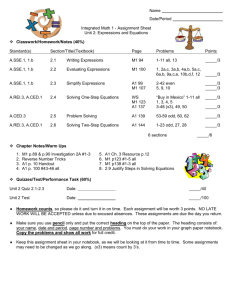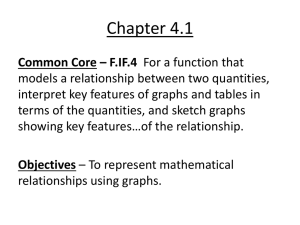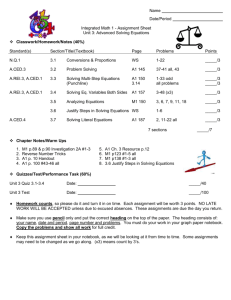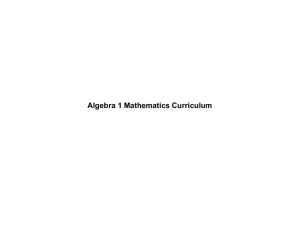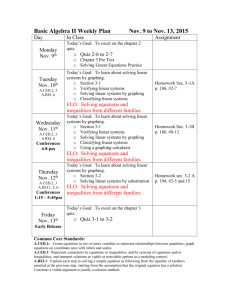Algebra I - CCSD Learning Targets
advertisement
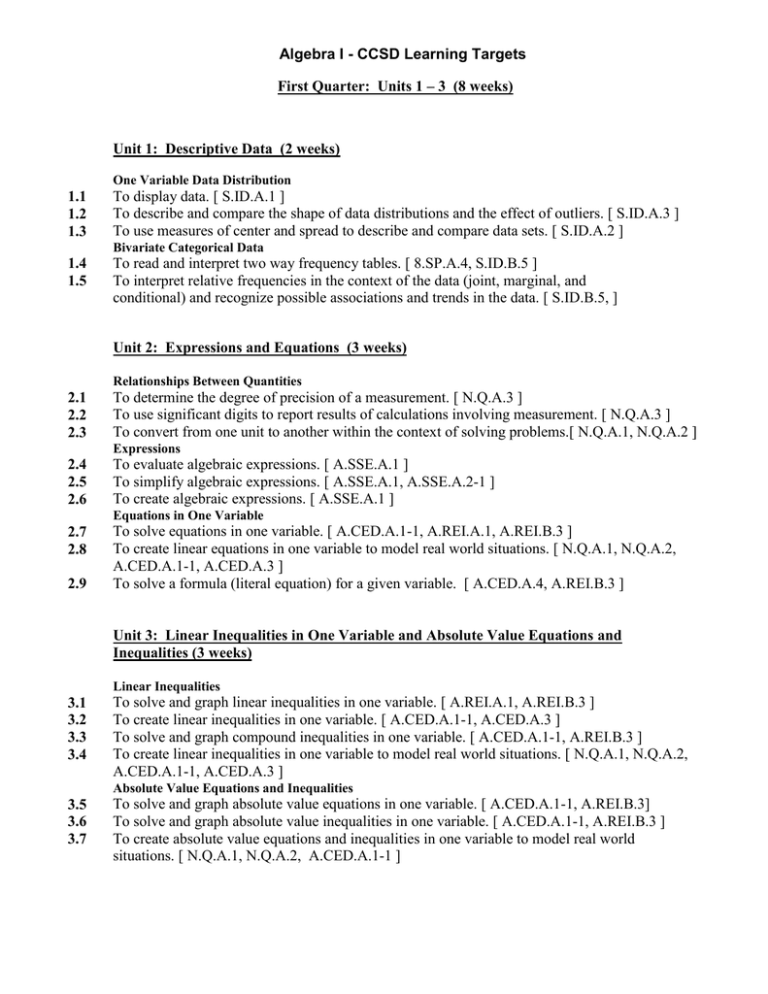
Algebra I - CCSD Learning Targets First Quarter: Units 1 – 3 (8 weeks) Unit 1: Descriptive Data (2 weeks) One Variable Data Distribution 1.1 1.2 1.3 To display data. [ S.ID.A.1 ] To describe and compare the shape of data distributions and the effect of outliers. [ S.ID.A.3 ] To use measures of center and spread to describe and compare data sets. [ S.ID.A.2 ] Bivariate Categorical Data 1.4 1.5 To read and interpret two way frequency tables. [ 8.SP.A.4, S.ID.B.5 ] To interpret relative frequencies in the context of the data (joint, marginal, and conditional) and recognize possible associations and trends in the data. [ S.ID.B.5, ] Unit 2: Expressions and Equations (3 weeks) Relationships Between Quantities 2.1 2.2 2.3 To determine the degree of precision of a measurement. [ N.Q.A.3 ] To use significant digits to report results of calculations involving measurement. [ N.Q.A.3 ] To convert from one unit to another within the context of solving problems.[ N.Q.A.1, N.Q.A.2 ] Expressions 2.4 2.5 2.6 To evaluate algebraic expressions. [ A.SSE.A.1 ] To simplify algebraic expressions. [ A.SSE.A.1, A.SSE.A.2-1 ] To create algebraic expressions. [ A.SSE.A.1 ] Equations in One Variable 2.7 2.8 2.9 To solve equations in one variable. [ A.CED.A.1-1, A.REI.A.1, A.REI.B.3 ] To create linear equations in one variable to model real world situations. [ N.Q.A.1, N.Q.A.2, A.CED.A.1-1, A.CED.A.3 ] To solve a formula (literal equation) for a given variable. [ A.CED.A.4, A.REI.B.3 ] Unit 3: Linear Inequalities in One Variable and Absolute Value Equations and Inequalities (3 weeks) Linear Inequalities 3.1 3.2 3.3 3.4 To solve and graph linear inequalities in one variable. [ A.REI.A.1, A.REI.B.3 ] To create linear inequalities in one variable. [ A.CED.A.1-1, A.CED.A.3 ] To solve and graph compound inequalities in one variable. [ A.CED.A.1-1, A.REI.B.3 ] To create linear inequalities in one variable to model real world situations. [ N.Q.A.1, N.Q.A.2, A.CED.A.1-1, A.CED.A.3 ] Absolute Value Equations and Inequalities 3.5 3.6 3.7 To solve and graph absolute value equations in one variable. [ A.CED.A.1-1, A.REI.B.3] To solve and graph absolute value inequalities in one variable. [ A.CED.A.1-1, A.REI.B.3 ] To create absolute value equations and inequalities in one variable to model real world situations. [ N.Q.A.1, N.Q.A.2, A.CED.A.1-1 ] Second Quarter: Units 4 – 6 (8 weeks) Unit 4: Functions and Function Notation (2 weeks) Graphing Relationships 4.1 To describe a relationship given a graph and to sketch a graph given a description. [F.IF.B.4, 8.F.B.5 ] Functions and Models 4.2 4.3 To determine if a relation is a function. [ F.IF.A.1 ] To use functions to model real world situations. [ F.IF.A.2, F.IF.B.4, A-CED.A.2 ] Arithmetic Sequences 4.4 4.5 4.6 4.7 To define and recognize an arithmetic sequence. [ F.IF.A.3 ] To graph an arithmetic sequence. [ F.LE.A.2 ] To write recursive and explicit formulas of an arithmetic sequence. [ F.BF.A.1a, F.BF.A.2 ] To use an arithmetic sequence to model a real world situation. [ F.BF.A.2, F.LE.A.2 ] Unit 5: Linear Functions and Linear Inequalities in Two Variables (3.5 weeks) Graph Linear Functions 5.1 5.2 5.3 5.4 5.5 To identify a linear function from a table, graph, or equation. [ F.LE.A.1b, A.REI.D.10, F.IF.C.7a, F.LE.A.2 ] To use intercepts to graph linear functions in standard form. [ F.IF.B.4-1, F.IF.C.7a ] To relate constant rate of change and slope in linear relationships. [N.Q.A.1, F.IF.B.6-1 ] To graph linear equations using slope intercept form. [ F.IF.C.7a, A.CED.A.2, A.REI.D.10 ] To graph linear inequalities in two variables. [ A.CED.A.3, A.REI.D.12-1 ] Create Linear Functions 5.6 5.7 5.8 To create a linear equation in slope-intercept form. [ A.CED.A.2-1, F.LE.A.2 ] To create a linear equation in point-slope form. [ A.CED.A.2-1, F.LE.A.2 ] To create a linear equation in standard form. [ A.CED.A.2-1, F.LE.A.2 ] Unit 6: Modeling with Linear Functions (2.5 weeks) 6.1 6.2 6.3 6.4 6.5 6.6 To compare and interpret the slope and y-intercept of linear functions. [ F.IF.C.9-1, F.LE.B.5 ] To transform the graph of linear functions. [ F.LE.B.5, A.CED.A.2-1, F.BF.B.3-1 ] To find a linear model for a set of bivariate data. [ 8.SP.A.1, 8.SP.A.3, S.ID.B.6a, S.ID.B.6c, S.ID.C.7, 8.SP.A.2, F.LE.B.5 ] To use technology to find lines of best fit. [ S.ID.B.6a, S.ID.B.6c, S.ID.C.8 ] To use residuals to determine how well lines of best fit model the data. [ S.ID.B.6a, S.ID.B.6c, S.ID.C.8 ] To identify correlations between data sets. [ S.ID.C.8, S.ID.C.9 ] Third Quarter: Units 7 – 9 (8.5 weeks) Unit 7: Systems and Linear Programming (3 weeks) Systems of Linear Equations 7.1 7.2 To solve a linear system of equations by graphing, substitution, and elimination. [ 8.EE.C.8, A.REI.C.5, A.REI.C.6, A.REI.D.11-1 ] To know that a system of two linear equations can have zero, one, or infinitely many solutions. [ A.REI.C.6, 8.EE.C.8 ] Systems of Linear Inequalities 7.3 To solve and graph systems of linear inequalities. [ A.REI.D.12-1 ] Linear Programming 7.4 7.5 To graph constraints and identify vertices of the feasible region. [ A-CED.A.3-1, A.REI.D.12-1 ] To use the vertices to maximize or minimize the objective function. [ A-CED.A.3-1 ] Unit 8: Exponential Functions and Geometric Sequences (3 weeks) Rational Exponents 8.1 8.2 8.3 To simplify expressions with zero and integer exponents. [ 8.EE.A.1, N.RN.A.1 ] To rewrite expressions involving radicals and rational exponents using the properties of exponents. [ N.RN.A.1, N.RN.A.2, N.RN.B.3 ] To put radicals in simplest form. [ N.RN.A.1, N.RN.A.2, 8.NS.A.2 ] Geometric Sequences 8.4 8.5 8.6 8.7 To define and recognize geometric sequences. [ F.LE.A.2, F.LE.A.3 ] To graph geometric sequences. [ F.LE.A.2, F.LE.A.3 ] To write recursive and explicit formulas of geometric sequences. [ F.BF.A.1a, F.BF.A.2, F.LE.A.2 ] To use geometric sequences to model real world situations. [ F.BF.A.2, F.LE.A.1a, F.LE.A.2 ] Graph Exponential Functions 8.8 8.9 8.10 To identify exponential functions from a table, graph, and equation. [ F.LE.A.1a, F.LE.A.1c ] To graph exponential functions using key features. [ F.IF.C.7e-1, F.IF.B.4-1, F.IF.C.8b, F.LE.B.5 ] To transform the graph of exponential functions. [ F.BF.B.3-1, F.IF.C.9, F.BF.A.1b ] Create and Model Exponential Functions 8.11 To create and evaluate exponential equations from real world situations. [ F.LE.A.1c, F.IF.C.8b, A.SSE.B.3c ] Solve Exponential Equations 8.12 To solve simple exponential equations. [ A.CED.A.1-1 ] Compare Linear and Exponential Functions 8.13 To compare properties of two functions represented algebraically, graphically, in tables or by verbal descriptions. [ F.IF.C.9-1, F.LE.A.1c, F.LE.A.1a, F.LE.A.1b, F.LE.A.3 ] Unit 9: Polynomials and Factoring (2.5 weeks) 9.1 9.2 9.3 9.4 To classify polynomials and write polynomials in standard form. [ A.SSE.A.1, A.SSE.A.2 ] To add and subtract polynomial expressions. [ A.APR.A.1, A.SSE.A.1, A.CED.A.1 ] To multiply polynomial expressions. [ A.APR.A.1, A.SSE.A.1, A.CED.A.1 ] To factor polynomials. [ A.SSE.A.2-1 ] Fourth Quarter: Units 10 – 12 (8 weeks) Unit 10: Graphing Quadratic Functions (2 weeks) 10.1 10.2 10.3 10.4 10.5 To graph quadratic functions in standard form. [ F.IF.C.7a ] To graph quadratic functions in factored form. [ F.IF.C.7a, F.IF.C.8a, F.BF.B.3-1 ] To graph quadratic functions in vertex form. [ F.IF.C.7a, F.IF.C.8a ] To transform the graphs of quadratic equations. [ F.BF.B.3-1, F.IF.B.4 ] To compare properties of two or more functions represented in different ways. [ F.IF.C.9-1, F.LE.B.5, F.LE.A.1 ] Unit 11: Solving Quadratic Equations (4 weeks) 11.1 11.2 11.3 11.4 11.5 11.6 11.7 11.8 11.9 To review number sets and introduce the existence of imaginary numbers. [ A.REI.B.4b, 8.NS.A.1, N.RN.B.3 ] To use the graph of a quadratic function to solve its related quadratic equation. [ N.RN.B.3, F.IF.C.7c ] To solve quadratic equations by taking the square root. [ A.REI.B.4b ] To solve quadratic equations by factoring. [ A.REI.B.4b, A.SSE.B.3a, A.SSE.A.2 ] To solve quadratic equations by completing the square. [ A.REI.B.4a, F.IF.C.8a, A.SSE.B.3b, A.SSE.A.2, A.REI.B.4b ] To solve quadratic equations using the quadratic formula. [ A.REI.B.4a, A.REI.B.4b ] To choose the best algebraic method to solve a quadratic equation. [ A.REI.B.4b ] To model real world situations with quadratic equations. [ N.Q.A.1, A.CED.A.2, F.IF.B.4, F.IF.B.5 ] To solve a simple system involving a linear and quadratic equation, both algebraically and graphically. [ A.REI.C.7, F.IF.C.7a ] Unit 12: Special Functions (2 weeks) Inverse Functions 12.1 12.2 To find the inverse of a linear function. [ F.BF.B.4a-1, F.BF.B.4c, A.CED.A.4 ] To graph the inverse of a linear function. [ F.IF.C.7a, F.BF.B.4a-1 ] Piecewise Functions 12.3 12.4 To graph linear piecewise functions including absolute value and step functions. [ F.IF.C.7b-1, F.BF.B.3 ] To define a piecewise function represented by a graph or real world function. [ F.IF.B.5-1, F.IF.C.7b ]
